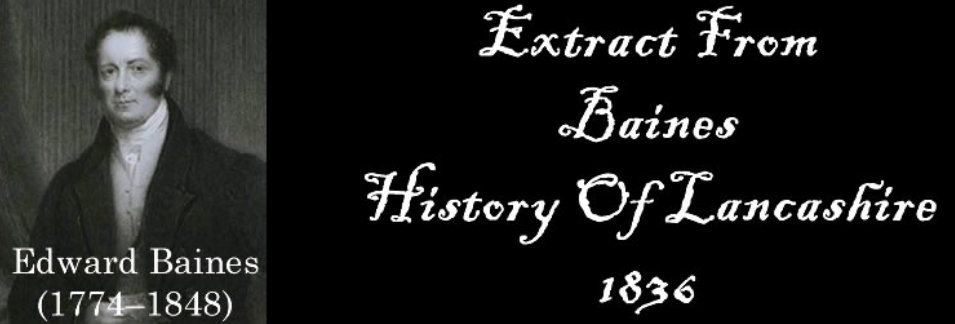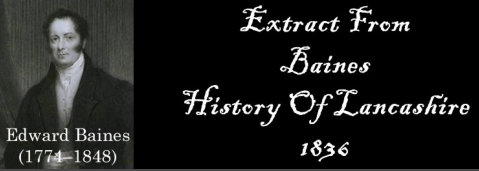




Local History
Baines
An Extract From Baines History Of Lancashire 1836
Longton was one of the manors which were granted by Roger de Lacy on obtaining the barony of Penwortham, to Robert the brother of Hugh, the last baron of the name Bussel. Richard Bussel, the second baron, had given, in the reign of William Rufus, two bovates of land in Longeton to the abbey of Evesham. The convent, by an ancient achronical charter, granted to Richard, son of .... Bambel, a part of that land which Robert, son of Richard, son of Sibilla de Longton, had granted to the church of Penwortham. By a similar deed, Geoffrey Bussel of Leyland, quit claims to John de Farington, son of William de Mel, the homages and services of certain of his free tenants in the town of Longeton, with the reliefs, wardships, and other honours belonging to the demense, viz. the homage and service of Alice, wife of Robert Bussel, viz. one pair of white gloves the homage and service of Roger son of Thomas Bussel, being also a pair of white gloves. A translated deed, also without date, shews that, ";Tho. sonne of Rote Bushell gr. to Henry sonne of George of Longton & his heires one pte of his lands in Longton for his homage and service, and boundaries the same to hold of him & his heirs by fealty & 1 penny yearly Rent att the Feast of the Assumpcion of oure Lady". Robert Bussel also granted to the priory of Burscough three acres of land in the field of Turmireacres, in the town of Longton, and the field of Reskelde in the same town. Of these donations, a charter of confirmation was granted in 17 Edward II. From other deeds of high antiquary, it appears that a family taking their name from Howick were landowners in Longton by gift of the Bussels, particularly Geoffrey and Robert, but, in 40 Edward III sir William del Lee held a quarter of the manor of Langton and moiety of Crofton and Maudisleigh. From the Lees it passed to Fleming of Leyland, descended from Fleming, baron of Wath, and in 9 Henry IV, sir Thomas Fleminge gave to Henry, " sonne of Ralph de Brethirton & his heires his whole lordship of Longton with all his rents and services: in 6 Edward IV Hugh de Bretherton "confirmes vnto Willo Fleminge the 4th pte of the manner of Longton to hold of the cheefe Lord, or Lords of the Fee, and also releases all his right and title vnto him." Of this family was Elizabeth, coheiress of her brother John Fleming, who married Thurstan Hall, in the reign of Henry VIII. Robert Moss esq. is now the reputed Lord of this Manor. Longton-Hall, built in the seventeenth century, is now a farm house. The Episcopal chapel, a plain brick fabric, was in existence in 1650 and, having fallen into decay, was rebuilt in 1770 by a brief, of the date 1767, amounting to £1026. There is here a Methodist chapel, erected in 1813, in a manner so temporary, that it was found necessary to rebuild it in 1833 There are no markets or fairs in this parish, but an annual rural feast is celebrated at Candlemas, in Longton, where bull-baiting used to form one of the most attractive of the sports; but, to the honour of the inhabitants, this barbarous pastime has been discontinued for some years, though there are not wanting gothic tastes that would revive it, to stimulate depraved appetites. Half a century ago, May-poles were erected, and garlands woven, early in the spring at Middleforth-green, and on the edge of the Moss, when "merry nights" were kept, with morris-dances and rustic finery, but there is now scarcely a vestige left of the olden times.
LongtonOnline.co.uk



Baines
An Extract From Baines History
Of Lancashire 1836
Longton was one of the manors which were granted by Roger de Lacy on obtaining the barony of Penwortham, to Robert the brother of Hugh, the last baron of the name Bussel. Richard Bussel, the second baron, had given, in the reign of William Rufus, two bovates of land in Longeton to the abbey of Evesham. The convent, by an ancient achronical charter, granted to Richard, son of .... Bambel, a part of that land which Robert, son of Richard, son of Sibilla de Longton, had granted to the church of Penwortham. By a similar deed, Geoffrey Bussel of Leyland, quit claims to John de Farington, son of William de Mel, the homages and services of certain of his free tenants in the town of Longeton, with the reliefs, wardships, and other honours belonging to the demense, viz. the homage and service of Alice, wife of Robert Bussel, viz. one pair of white gloves the homage and service of Roger son of Thomas Bussel, being also a pair of white gloves. A translated deed, also without date, shews that, ";Tho. sonne of Rote Bushell gr. to Henry sonne of George of Longton & his heires one pte of his lands in Longton for his homage and service, and boundaries the same to hold of him & his heirs by fealty & 1 penny yearly Rent att the Feast of the Assumpcion of oure Lady". Robert Bussel also granted to the priory of Burscough three acres of land in the field of Turmireacres, in the town of Longton, and the field of Reskelde in the same town. Of these donations, a charter of confirmation was granted in 17 Edward II. From other deeds of high antiquary, it appears that a family taking their name from Howick were landowners in Longton by gift of the Bussels, particularly Geoffrey and Robert, but, in 40 Edward III sir William del Lee held a quarter of the manor of Langton and moiety of Crofton and Maudisleigh. From the Lees it passed to Fleming of Leyland, descended from Fleming, baron of Wath, and in 9 Henry IV, sir Thomas Fleminge gave to Henry, " sonne of Ralph de Brethirton & his heires his whole lordship of Longton with all his rents and services: in 6 Edward IV Hugh de Bretherton "confirmes vnto Willo Fleminge the 4th pte of the manner of Longton to hold of the cheefe Lord, or Lords of the Fee, and also releases all his right and title vnto him." Of this family was Elizabeth, coheiress of her brother John Fleming, who married Thurstan Hall, in the reign of Henry VIII. Robert Moss esq. is now the reputed Lord of this Manor. Longton-Hall, built in the seventeenth century, is now a farm house. The Episcopal chapel, a plain brick fabric, was in existence in 1650 and, having fallen into decay, was rebuilt in 1770 by a brief, of the date 1767, amounting to £1026. There is here a Methodist chapel, erected in 1813, in a manner so temporary, that it was found necessary to rebuild it in 1833 There are no markets or fairs in this parish, but an annual rural feast is celebrated at Candlemas, in Longton, where bull-baiting used to form one of the most attractive of the sports; but, to the honour of the inhabitants, this barbarous pastime has been discontinued for some years, though there are not wanting gothic tastes that would revive it, to stimulate depraved appetites. Half a century ago, May-poles were erected, and garlands woven, early in the spring at Middleforth-green, and on the edge of the Moss, when "merry nights" were kept, with morris-dances and rustic finery, but there is now scarcely a vestige left of the olden times.

Local History
























































